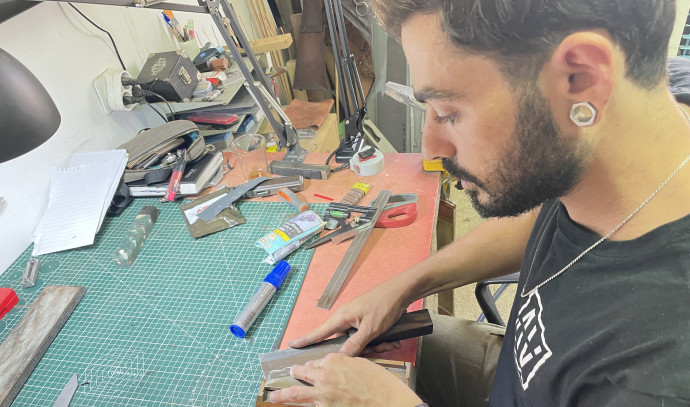Daniel Nave always had a love for sharp things.
As a kid, his “great knife collection” included “swords, axes, and everything in between.” Now 31, the namesake of Nave Knives is one of the only handmade artisan chef knife-makers in Israel, and from his studio on Kibbutz Gesher Haziv, outside Nahariya, he is fashioning the tools for Israel’s best chefs.
For Nave, his path to knife-making was sparked while he was studying psychology at Tel-Hai College. This, he said, was a wake-up call, since growing up in Herzliya his mindset had not been geared toward creative endeavors. “Herzliya is like a Tel Aviv mindset. It is a different mentality,” he says, referring to the White City’s reputation for materialism.
At one point, he became interested in cooking and got hooked on kitchen knives. He began buying Japanese knives – which have a storied history as some of the world’s best kitchen utensils – as well as European ones. Thanks to his new-found love for creativity, Nave was motivated to make a knife of his own. He immediately fell in love with the process and went full-force into learning the art of knife-making.
His hobby began to grow, as he bought the necessary tools and equipment, and reading all the books on the subject. Then COVID came.
For many people during the pandemic, so much free time afforded them the opportunity to explore their passions and hobbies, which for many became their full-time professions. Nave was no different. A bartender prior to the pandemic, he decided when things shut down that “now is the time” to become a legitimate knife producer.
Living near the Golan – he moved to the kibbutz three and a half years ago – he dove into books on the topics of metals, knife-making, and geometry, which he says is the key to a sharp knife. Asked about YouTube learning, he said that on the topic of knives “90% of the information isn’t correct.”
Nave began by focusing on two types of steel: 52100 and 011084. These metals helped him gain a grasp of how to make good knives. Crediting government stimulus payments for keeping him afloat, Nave spent a year just making knives for himself. As he progressed, people around him expressed a desire to purchase his work, but he didn’t know if it was good enough to sell.
“I didn’t know if my grinding, sharpening, gluing, and the rest was good enough.”
He started giving some of his knives away to friends, and the reviews were stellar. The feedback made him feel comfortable enough to begin selling knives made with simple durable steels, taking it on full time in “one swoop.”
He quickly transitioned to high-quality stainless steel, an extremely sharp and durable steel. Other popular metals, he says, such as carbon steel, require constant maintenance, oiling, and proper storage – or else they will be ruined.
Nave stands by his work. His knives come with a lifetime of free sharpening if clients come to his studio on the kibbutz.
Creating the sharpest knives in Israel
TODAY, NAVE is arguably the premier knife-maker in the Holy Land, producing around 80 chef knives a year. The knives, which range from NIS 1,600 to NIS 2,500, or more for custom orders, take approximately 20 hours to complete. While this may sound expensive, it is very much in line with high-quality knives from Japan and elsewhere.
The work is usually carried out over a period of a few days, since apart from the physical labor involved, there is a lot of waiting time in the knife-making process. He produces all types of kitchen knives from traditional chef knives, which are the majority of his orders, to paring knives and long fish knives.
Nave also leads one- and two-day knife-making workshops, which allows individuals to go to his studio and handcraft create their own top-quality kitchen knives to take home.
He begins the workshop by explaining the specificity of knives. For example, a chef’s knife is not supposed to be used to debone a chicken, unless you want your knife to break. He then speaks about the trade-offs in steelwork as it pertains to knives: “You can either go sharp or strong.”
Strong knives are typically softer steels, making them less likely to break. Sharp knives, the majority of the knives seen in the best kitchens in the world, are made from hard steel that becomes very sharp. The downside to this is that even a simple fall onto a hard surface can snap the blade.
The great benefit of hard steels is that they allow the knife to retain its “edge,” the angle that creates the sharpness, over a long period of time. Nave says that “edge retention is very important,” and that “softer steels won’t hold an edge.”
This plays into Nave’s mission to create the “sharpest knives around,” which today grace the kitchens of top Israeli chefs such as Meir Adoni and Yossi Shitrit.
In the workshop, we made a Japanese nakiri knife, traditional for cutting vegetables, and what Nave described as “very straightforward to make.” The process was fun and intense. Knife-making starts by using the steel that Nave has cut and heat-treated prior to the workshop, a long and tedious process that ensures hardness. From there, it goes through nitro-cooling and gyro treatment, at which point it is ready for grinding.
The grinding process starts the procedure of creating the edge. Slowly but surely, beginning with a piece of coarse paper on a fast-moving wheel, the shape is formed. Nave’s goal in his knives is to achieve a thickness of between 0.1 and 0.2mm.
WATCHING NAVE achieve this thickness was a masterclass in the craft. His profound knowledge and love for knife-making were abundantly clear. He subtly nodded approval as he frequently checked the thickness and shape of the knife as he brought his artwork to life.
There is always something special about watching true craftspeople at work. Engaged in their practice, whether it be artwork, cooking, or creating something unique, their drive and love for their artistry is palpable in their finished product.
Nave is exemplifying this dedication to his craft.
After the grinding process, the knife was sharpened with a diamond, and then fitted with his hand-cut natural wood handles
Nave spoke of the uniqueness of each handmade knife, explaining that no two knives can ever be the same. That is the beauty of artisanal art – every item is unique to its maker and to the client who purchases it.
As Nave finished his creation, he says his goal is to achieve 100 knives per year and showcase his skills on the international stage. He confides that his greatest love is to “share his enthusiasm” for knife-making with others, and in turn, furthering the ancient art.



